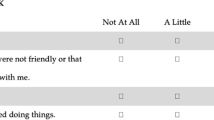Abstract
The 12-item clinician or self-administered Self-Efficacy Questionnaire for Depression in Adolescents (SEQ-DA) was developed as a measure of perceived ability to cope with depressive symptomatology. This study examined the reliability and validity of the SEQ-DA in a clinical population of 130 adolescents that were receiving treatment for depression. Psychometric evaluation revealed good internal consistency and test-retest reliability. Results indicated that higher SEQ-DA scores were associated with lower self-rated depression scores (Reynolds Adolescent Depression Scale), which is evidence of good construct validity. Further, higher SEQ-DA scores prior to treatment predicted better outcome at the end of the 3 months of treatment and at 6 months post-treatment. Therefore, the SEQ-DA has a potentially useful role in clinical work and research with depressed young people.
Similar content being viewed by others
References
Abramson LY, Seligman MEP, Teasdale JD (1978) Learned helplessness in humans: Critique and reformulation. J Abnorm Psychology 87:49–74
American Psychiatric Association (1994) Diagnostic and Statistical Manual of Mental Disorders-IV. Author, Washington DC
Arnstein P (2000) The mediation of disability by self efficacy in different samples of chronic pain patients. Disabil Rehabil 22:794–801
Bandura A (1982) Self-efficacy mechanisms in human agency. American Psychologist 37:122–147
Bandura A (1997) Self-efficacy: The exercise of control. WH, Freeman, New York
Bandura A (1977) Self-efficacy: Toward a unifying theory of behavioral change. Psychol Rev 84:191–215
Bandura A, Pastorelli C, Bargaranelli C, Caprara GV (1999) Self-efficacy pathways to childhood depression. J Pers Soc Psychol 76:258–269
Barlow JH, Cullen LA, Rowe IF (2002) Educational preferences, psychological well-being and self-efficacy among people with rheumatoid arthritis. Patient Education and Counselling 46:11–19
Beck AT (1976) Cognitive therapy and the emotional disorders. International Universities Press, New York
Bernier M, Avard J (1986) Self-efficacy, outcome, and attrition in a weight-reduction program. Cognitive Therapy and Research 10:319–338
Dennis KE, Goldberg AP (1996) Weight control self-efficacy and relapse in smoking cessation programs. J Consult Clin Psychol 49:648–658
Edelbrock CS, Costello EJ, Dulcan MK, Kalas R, Conover NC (1985) Age differences in the reliability of the psychiatric interview of the child. Child Dev 56:265–275
Ehrenberg MF, Cox DN, Koopman RF (1991) The relationship between selfefficacy and depression in adolescents. Adolescence 26:361–374
Gordon M, Melvin G, Tonge B, King N, Heyne D, Summers D, Dudley A, Williams N, Bryant D, Burdett L, Kurts S, Rowe L (2003) Predictors of treated adolescent depression at 6 months follow-up. Paper presented at the Faculty of Child and Adolescent Psychiatry 2003 National Conference: Strategies for young minds: Emotions, behaviour and development, Carlton Crest Hotel, Melbourne Australia
Gulliver SB, Hughes JR, Solomon LJ, Dey AN (1995) Self-efficacy and relapse to smoking in self-quitters. Addiction 90:767–772
Hawkins RMF (1995) Self-efficacy: a cause of debate. J Behav Ther Exp Psychiatry 26:235–240
Hawkins RMF (1992) Self-efficacy: a predictor but not a cause of behavior. J Behav Ther Exp Psychiatry 23:252–256
Kavanagh DJ, Wilson PH (1989) Prediction of outcome with group cognitive therapy for depression. Behav Res Ther 27:333–343
Kirsch I (1985) Self-efficacy and expectancy: old wine with new labels. J Personality Soc Psychol 42:132–136
Litt MD (1988) Self-efficacy and perceived control: Cognitive mediators of pain tolerance. J Personality Soc Psychol 54:149–160
Mathers CD, Vos ET, Stevenson CE, Begg SJ (2001) The burden of disease and injury in Australia. Bulletin of the World Health Organization 79:1076–1084
Melvin G, Klimkeit E, Tonge B, King N, Gordon M, Rowe L, Dudley A, Williams N (2003) A comparison of cognitive-behavioural therapy and pharmacotherapy for adolescent depression: the Time for a Future Project. Paper presented at the Faculty of Child and Adolescent Psychiatry 2003 National Conference: Strategies for young minds: Emotions, behaviour and development. Carlton Crest Hotel, Melbourne Australia
Moretti MM, Fine S, Haley G, Marriage K (1985) Childhood and adolescent depression: child-report versus parent-report information. J Am Acad Child Adolesc Psychiatry 24:298–302
Muris P (2001) A brief questionnaire for measuring self-efficacy in youths. J Psychopathol Behav Assess 23:145–149
Muris P (2002) Relationships between self-efficacy and symptoms of anxiety disorders and depression in a normal adolescent sample. Pers Indiv Diff 32:337–348
Nelson C (1996) Importance of intent-to-treat response rates for the clinician. Psychiatric Annuals 26:8–18
Patton GC, Coffey C, Posterino M, Carlin JB, Wolfe R (2000) Adolescent depressive disorder: A population-based study of ICD-10 symptoms. Aust N Z J Psychiatry 34:741–747
Reynolds WM (1986) Reynolds Adolescent Depression Scale—Professional Manual. Psychological Assessment Resources, Florida
Reynolds WM, Mazza JJ (1998) Reliability and validity of the Reynolds Adolescent Depression Scale with young adolescents. J School Psychol 36:295–312
Shiffman S, Balabanis MH, Paty JA, Engberg J, Gwaltney CJ, Liu KS, Gnys M, Hickox M, Paton SM (2000) Dynamic effects of self-efficacy on smoking lapse and relapse. Health Psychol 19:315–323
Stotland S, Zurloff DC (1991) Relations between multiple measures of dieting self-efficacy and weight change in a behavioral weight control program. Behav Ther 22:47–59
Stuart K, Borland R, McMurray N (1994) Self-efficacy, health locus of control, and smoking cessation. Addict Behav 19:1–12
Tucker S, Brust S, Richardson B (2002) Validity of the depression coping self-efficacy scale. Arch Psychiatr Nursing 16:125–133
Author information
Authors and Affiliations
Corresponding author
Rights and permissions
About this article
Cite this article
Tonge, B., King, N., Klimkeit, E. et al. The Self-Efficacy Questionnaire for Depression in Adolescents (SEQ-DA). Europ.Child & Adolescent Psych 14, 357–363 (2005). https://doi.org/10.1007/s00787-005-0462-y
Accepted:
Issue Date:
DOI: https://doi.org/10.1007/s00787-005-0462-y




